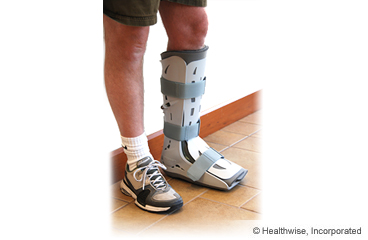
Overview
Walking boots protect broken bones and other injuries of the lower leg, ankle, or foot. They prevent more damage and help the area heal. Your doctor may have you use a boot for 1 to 6 weeks. How long you wear it depends on how serious your injury is.
Walking boots are removable, and most of them can be adjusted. Your doctor will show you how to remove and adjust your boot.
Most walking boots have straps. Some have built-in air cushions that hold the injured area in place. Some boots have settings that control how much your ankle can move. These boots are called controlled ankle movement (CAM) boots.
Adjust or remove the boot only when your doctor says it's okay. If your boot has CAM settings, do not change those settings.
Follow-up care is a key part of your treatment and safety. Be sure to make and go to all appointments, and call your doctor if you are having problems. It's also a good idea to know your test results and keep a list of the medicines you take.
How can you care for yourself at home?
General care
- Follow your doctor's instructions about how much weight you can put on your foot and when you can go back to your usual activities. If you were given crutches, use them as directed.
- Follow your doctor's instructions about adjusting the fit of the boot.
- If the toes on the leg with the boot were not injured, wiggle them every now and then. This helps move the blood and fluids in the injured leg.
- Prop up the injured leg on a pillow when you ice it or anytime you sit or lie down during the next 3 days. Try to keep it above the level of your heart. This will help reduce swelling.
- If your doctor told you how and when to use ice, follow your doctor's instructions. If you did not get instructions, follow this general advice:
- Be careful not to get the boot wet. Ask your doctor if you can take the boot off when you use ice.
- Put ice or cold packs on the leg for 10 to 20 minutes at a time. Put a thin cloth between the ice and your skin. Try to do this every 1 to 2 hours for the next 3 days (when you are awake) or until the swelling goes down.
- Keep up your muscle strength and tone as much as you can while protecting your injured leg. Your doctor may want you to tense and relax the muscles protected by the boot. Check with your doctor or your physical or occupational therapist for instructions.
Boot and skin care
- If your boot is not to be removed, try blowing cool air from a hair dryer or fan into the boot to help relieve itching. Never stick items under your boot to scratch the skin.
- Do not use oils or lotions near your boot. If the skin gets red or sore around the edge of the boot, you may pad the edges with a soft material, such as moleskin. Or you can use tape to cover the edges.
- If you're allowed to take your boot off, be sure your skin is dry before you put the boot back on. Be careful not to put the boot on too tightly.
- Check the skin under the boot every day. If you are not supposed to remove the boot, check the skin around the edges. Tell your doctor if you see redness or sores.
Water and your boot
- Keep your boot dry. Moisture can collect under the boot and cause skin irritation and itching. If you have a wound or have had surgery, moisture under the boot can increase the risk of infection.
- If your doctor says to keep your boot on to shower, protect it so that it won't get wet. Put your leg inside a plastic trash bag and tape the top around your leg.
- If you can take the boot off when you shower, pat the area dry after you shower. Then put the boot back on.
- If your boot gets a little wet, you can dry it with a hair dryer. Use the cool air setting.
When should you call for help?
Call your doctor now or seek immediate medical care if:
- You have severe or increasing pain.
- You have problems with your boot. For example:
- The skin under the boot is burning or stinging, or you have a warm or painful spot under the boot.
- You have numbness or tingling in the foot or toes that doesn't go away when you adjust the tightness of the boot.
- There is a lot of swelling near the boot. (Some swelling is normal.)
- You have a new fever.
- There is drainage or a bad smell coming from the boot.
- Your leg turns cold or changes color.
- You have trouble moving your toes.
- You have symptoms of a blood clot in your leg (called a deep vein thrombosis). These may include:
- Pain in the calf, back of the knee, thigh, or groin.
- Redness and swelling in your leg or groin.
Watch closely for changes in your health, and be sure to contact your doctor if:
- Your leg, ankle, or foot pain returns or increases after your doctor tells you to stop using the boot.
- You are not getting better as expected.
Current as of: July 31, 2024
Author: Ignite Healthwise, LLC Staff
Clinical Review Board
All Healthwise education is reviewed by a team that includes physicians, nurses, advanced practitioners, registered dieticians, and other healthcare professionals.

